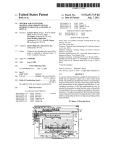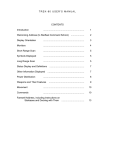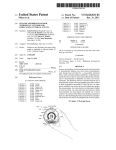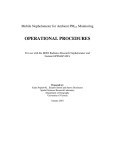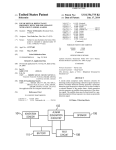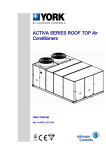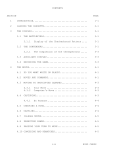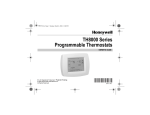Download Rapid programming of thermostat with multiple programming mode
Transcript
US008517088B2
(12) Ulllted States Patent
(10) Patent N0.:
Moore et al.
(54)
(45) Date of Patent:
RAPID PROGRAMMING OF THERMOSTAT
7,801,646 B2 *
9/2010 Amundson et al. ......... .. 700/276
7,861,941 B2 *
1/2011 Schultz et al.
7,867,646 B2 *
1/2011
IIWBIIIOFSI Glenn A- Moore, Geneva, IL (Us);
8,219,251 B2 *
7/2012 Amundson et al.
Daniel S. PoplaWski, OsWega, IL (US);
8,244,383 B2 *
8/2012 Bergman et al.
Robert M_ Rados Yorkville IL (Us)
8,280,536 B1 *
’
8,346,396 B2 *
Assignee: Braeburn Systems, LLC, Montgomery,
2004/0133314 A1
IL (US)
(*)
Notice:
Rhodes ............ ..
236/1 C
.. 429/100
8,083,154 B2 * 12/2011 Schultz et al.
8,167,216 B2 * 5/2012 Schultz et al.
’
(73)
Aug. 27, 2013
WITH MULTIPLE PROGRAMMING MODE
CONDITIONS
(75)
US 8,517,088 B2
*
236/94
236/51
.. 700/276
10/2012 Fadell et al. ..... ..
1/2013
Amundson et al.
700/17
700/83
700/276
7/2004 Ehlers et a1‘ """""""" " 700/276
(Continued)
Subject to any disclaimer, the term of this
patent is extended or adjusted under 35
Honeywell
OTHER PUBLICATIONS
International Inc., VisionPRO TH8000
U-S-C- 154(1)) by 228 days-
Touchscreen Programmable Thermostat Opening Manual, 2009.
(21) Appl. NO.Z 13/045,370
Series.
(Continued)
(22)
Filed:
Mar. 10, 2011
Primary Examiner * Ramesh Patel
(74) Attorney, Agent, or Firm * Arnstein & Lehr LLP
(65)
Prior Publication Data
US 2012/0232703 A1
Sep. 13, 2012
(57)
(51)
Int- Cl-
The invention provides for a controller such as a thermostat
for an HVAC S y stem comP rising a housing having a circuit
(52)
G05D 23/19
G051) 23/00
U-s- Cl-
(2006-01)
(2006-01)
board and a display screen, the display screen having at least
one alpha-numeric icon and a group of input control areas. A
microprocessor is provided for control on the display screen.
. . . . . . . . . . ..
(58)
Buttons are pressed in Order to program set_points of the
Field of Classi?cation Search
USPC
700/17418, 2764278, 2994300; 165/238,
165/254; 236/1 C, 91 D, 91 E, 91 R, 94;
715/70(%702
See application ?le for complete search history.
(56)
References Clted
US. PATENT DOCUMENTS
6,595,430 B1*
ABSTRACT
7/2003
Shah ......................... .. 236/46 R
7,156,317 B1 *
1/2007
Moore ..
7,274,972 B2 *
9/2007 Amundson et
. 236/49.3
700/276
7,438,469 B1
10/2008 Moore
7,614,567 B2 *
7,636,604 B2 *
7,784,705 B2 *
11/2009 Chapman et al. ........... .. 236/1 C
12/2009 Bergman et al. .
8/2010 Kasper et al. ............. .. 236/44 C
thermostat so that seven days may be programed simulta
neously. The display includes a seven-day icon so that the
user can program the thermostat set-points rapidly (e.g. set
ting time and temperature settings With minimal steps). The
user may activate a ?rst programming mode Wherein the
activating occurs by depressing a programming-mode button
for a ?rst pre-selected duration in order to select a ?rst day for
setting the conditioning mode. The user may activate a second
programming mode Wherein such activating occurs by
depressing the programming-mode button for a second pre
selected duration that is longer than the ?rst pre-selected
duration in order to select programming for all seven days
simultaneously.
17 Claims, 4 Drawing Sheets
US 8,517,088 B2
Page 2
(56)
References Cited
U.S. PATENT DOCUMENTS
2004/0193324
2004/0256472
2005/0033707
2012/0168524
2012/0169675
A1* 9/2004 Hoog et a1. ................. .. 700/276
A1* 12/2004 DeLuca .... ..
236/46 R
A1* 2/2005 Ehlers et a1.
. 705/412
A1* 7/2012 Moore et al.
. 236/1 C
A1* 7/2012 Moore et al. ................ .. 345/184
OTHER PUBLICATIONS
PRO1 IAO, True Comfort IIII Model T955 Operating Manual, 2010.
White Rodgers, Big Blue Humidity Universal Thermostat, Model
11395-1291 Instructions (admitted prior art).
* cited by examiner
US. Patent
Aug. 27, 2013
Sheet 1 of4
US 8,517,088 B2
US. Patent
Aug. 27, 2013
15Gb
Sheet 2 of4
US 8,517,088 B2
10
\ 110
‘IL-1“
152
_l_______ _
CLEAN
SYSTEM
I—/
A
‘*1 Fl
n
22
FAN
\__......—)
AUTO
é
HOLD
3333-1
"71 u‘
[151m
DAY] TIME
/
154
140
‘119
Fig. 2
OUTDOOR
US. Patent
Aug. 27, 2013
Sheet 3 of4
US 8,517,088 B2
15Gb
12
152 \
1/25
/
l
\i svsnzm
120
—r-——-”
HEAT
DFF
_ 124
FAN
M TU W TH F SA SU
AUTO
SET AT
{
\ mm,
I I
/__'—
I- '
_
/
160
mm
- \
1 i \
[ BACK ] NEXT
/
RETURN
--—15DC
1
l
I
\
Q
157
.
155
Figure 3
150b
12
152-_.__
I
SYSTEM
120
HEAT
AUTO
\SETATI
MTuwTHFsAsu/
,uccuPlm l ,
-||-
n
__
_
| —|
/
A
'
’
'
| “
’
P-—124
\-160
L W“?
' SET
( BAcK 1 [ NEXT ] [ RETURN }——150c
!\
\
167
165
\
157
/
I
k
155
US. Patent
Aug. 27, 2013
Sheet 4 of4
US 8,517,088 B2
7 Day
Programming
(
<3 Seconds
' ROG Button
Duration?
Cali individual
Day
Programming
Routine
Call 7 Day
Routine, Display
C’all 7 Days,
Display First
Event
Hour Flashes.
I
Adjust Hour for _,..-_. D
Event, Press
NEXT Button
iv
Minute Flashes.
Adjust Minute for ,.--.. E
Event. Press
NEXT Button
I
Temperature
Flashes. Adjust
lncrementto
Next Event
Temperature for ’
Event, Press
NEXT Button
iv
Fan Setting
Flashes. Adjust
Fan Control for r" "G
Event, Press
NEXT Button
Exit 7 Day
Routine and
Display Home
Screen
Fig. 5
US 8,517,088 B2
1
2
RAPID PROGRAMMING OF THERMOSTAT
WITH MULTIPLE PROGRAMMING MODE
CONDITIONS
may be a combination of a mechanical button and a touch
sensitive area button. In an embodiment, a mechanical button
may be a rocker sWitch.
In an embodiment, the method may comprise the step of
selecting the temperature and duration for a fractional day
period, such as a morning period, a daytime period, an
evening period, a night period, occupied period or unoccu
pied period. In an embodiment, the method may further com
prise the step of selecting a fan setting.
The present invention may further comprise a thermostat
display for programming a thermostat comprising a thermo
The present invention pertains to a display and method for
rapid programming of a thermostat in order to control mul
tiple functions of an HVAC system controlled by the thermo
stat.
BACKGROUND
stat including a system button and a program button, a display
screen including a seven day icon, a temperature icon and a
time icon, Wherein activation of the program button selects
the seven day icon and activation of the system button pro
Thermostats typically have multiple functions that require
user input, such as setting time of day, day of Week, program
ming temperature set points or programming user settings.
Control panels typically include an assortment of buttons for
vides for selection of one of a heat mode and a cool mode and
operating the thermostat and adjusting the settings. Adjust
for programming all seven days simultaneously for one of the
ment of the thermostat settings using the assortment of but
tons can often times be confusing to the user, require detailed
revieW of user manual and consume much time in order to
modes by adjustment of the temperature and time icons.
In an embodiment, the seven day icon may comprise an
20
properly operate the thermostat and adjust the settings to the
Week. In an embodiment, the icon may comprise “M TU W
TH F SA SU.” In an embodiment, the temperature and time
icons may comprise an alpha-numeric representation. In an
user’ s liking.
In some cases a liquid crystal display (LCD) may be pro
vided that includes touch sensitive areas populated on the
display screen. The touch sensitive area may include numer
embodiment, a rocker sWitch may be provided for adjusting
25
als, Word phrases or graphics (collectively, “icons”) that
appear on the display screen. By touching the appropriate
icon, the user can make adjustments to the functioning of the
thermostat and activate speci?c modes of operation or make
setting adjustments. Some thermostats are knoWn to have
mechanical buttons or sWitches (“hard buttons”). Such hard
buttons are commonly used in combination With touch sen
30
35
40
day and Weekend day. When programming includes setting
hour, minute, temperature and fan settings: the total number
steps and inputs required to complete the programming for
seven days may exceed 100 steps. The present invention
overcomes many of the above mentioned disadvantages of
previously knoWn thermostats and alloWs for more rapid pro
The present invention may also provide for a computer
readable media having stored thereon computer executable
instructions for programming a thermostat, the instructions,
When executed by a computing device, perform the steps
comprising displaying a system button, displaying a program
button, displaying a seven day icon, displaying a time icon,
displaying a temperature icon, selecting the seven day icon
upon activation of the program button, selecting one of the
45
heat mode or cool mode upon activation of the program
button and simultaneously programming seven days for the
heat mode or cool mode by adjusting set points via the time
and temperature icons.
gramming of the thermostat.
SUMMARY
In an embodiment, the seven day program may comprise an
50
alpha numeric representation of each of the seven days of a
Week. In an embodiment, the time and temperature icons may
comprise an alpha-numeric representation. In an embodi
ment, a rocker sWitch for adjusting the set points for tempera
ture and time modes may be provided for a period. In an
55
embodiment, the complete programming of the seven days
for the heating or cooling may be provided Without requiring
The present invention provides for a method for pro gram
ming a thermostat comprising the steps of providing a ther
mostat having a display and buttons for controlling at least
tWo modes of a thermostat, including a heating mode and a
cooling mode and a thermostat capable of controlling the
heating and cooling modes for each of seven days, activating
determined time trigger so that pressing the program button
for a period of time greater than the pre-determined time
trigger results in activation of a seven day programming mode
and pressing the program button for a period of time less than
the predetermined time trigger results in activation of an
individual day programming mode. In an embodiment, the
system button and program button may be touch sensitive
areas displayed on the display screen of the thermostat.
and corresponding temperature) for each day of the Week.
The process of pro gramming is typically repeated seven times
so that the proper set-points are programmed for each Week
set points for temperature and time of the modes. In an
embodiment, a fan button may be provided for selecting a fan
mode for the heat and cool modes.
In an embodiment, the program button may include a pre
sitive areas (“soft buttons”) on a LCD. Some thermostats have
multiple hard buttons on different portions of the thermostat
housing. Typically the user must program the thermostat by
using the soft or hard buttons to adjust set-points (e.g. time
alpha-numeric representation of each of the seven days of the
a ?rst programming mode in order to select all seven days
simultaneously, displaying a seven day icon on the display
an increment from a ?rst day to a second day during user input
to program the thermostat.
during the heating mode selection, activating a second pro
gramming mode in order to select all seven days for the
selection.
In an embodiment, the buttons may be mechanical buttons
disposed on a housing of the thermostat. In an embodiment,
the buttons may be touch sensitive areas displayed on a dis
play screen of the thermostat. In an embodiment, the buttons
BRIEF DESCRIPTION OF THE DRAWINGS
60
cooling mode for all seven days simultaneously, and display
ing the seven day icon on the display during the cooling mode
For a better understanding of the subject invention, refer
ence may be had to embodiments shoWn in the attached
draWings in Which:
65
FIG. 1 is a schematic diagram of the present invention;
FIG. 2 is a plan vieW of a thermostat of the present inven
tion;
US 8,517,088 B2
4
3
FIGS. 3-4 are diagrammatic vieWs of the display screen
are displayed including “70” Which is displayed beloW the
illustrating examples of operation of the present invention;
alpha-numeric icon “SET AT” 117; so “70” is the set point at
Which the thermostat is set to trigger the HVAC system.
Numeric icon “12:00” (119) indicates a set point at Which the
and
FIG. 5 is How diagram of the present invention.
temperature should be at 70 degrees. According to the alpha
DETAILED DESCRIPTION
numeric icon “TU MOR ” 122 indicating that on Tuesday
mornings at 12:00 p.m., the set point should be 70 degrees
An embodiment of the present invention is depicted With
respect to the folloWing FIGS. 1-5, and in particular an over
vieW of the electronic circuitry and components of the ther
mostat 10 of the present invention Will be described With
Fahrenheit. The display of the “TU MOR ” icon 122 indi
cates that a single/day programming mode has been selected
by depressing the “SYSTEM” touch sensitive area 152 for
less than three seconds.
The graphical icon 140 in this embodiment is a represen
tative pictorial of a fan blade and indicates that the fan mode
is on and running. Other types of graphical icons may be
provided on the display 12.
Other alpha-numeric icons 120 are included Within touch
sensitive area 150a, 1501). For example, as depicted on the
display 12 in the embodiment of FIG. 2, the touch sensitive
area 150a, 1501) that are provided and designated With alpha
respect to FIG. 1. The thermostat 10 includes a display 12
(including touch sensitive area 13), a microprocessor 14 and
sWitch 20. SWitch 1 is provided, Which may be opened and
closed in order to signal the microprocessor 14 (eg to incre
ment the selected set-point). As Well a SWitch 2, is provided
Which may be opened or closed to signal the microprocessor
14 (eg to decrement the selected set-point). The micropro
cessor controls the HVAC system 21 attached to the thermo
stat 10 and also is connected to the display 12, Which alloWs
for user input to adjust the system. For example, in a typical
HVAC system 21, the thermostat 10 Would be used to adjust
the heating or cooling of the system in order to provide a
comfortable environment for the occupants. The micropro
20
cessor 14 includes ROM Which may have softWare loaded
25
into it, in order to control the thermostat 10 and to provide for
the display screen functionality. The display screen 12
includes displayable touch sensitive areas (see FIG. 2). As
Will be discussed in greater detail beloW, the combination of
the actuation of SWitch 1 and SWitch 2 (via the rocker sWitch
numeric icons 120 are “CLEAN” “CONFIG” “HUMIDITY”
“OUTDOOR” “SYSTEM” “FAN” “PROG” (PROGRAM)
“HOLD” “DAY/TIME”. In the embodiment depicted in FIG.
2, the touch sensitive area 150a, 1501) are designated by
rectangular outlines provided the display screen 12. In an
alternate embodiment, the display screen 12 may have no
touch sensitive areas and may function solely to display
alpha-numeric 120, graphical 140, and numeric icons 110. In
30
such an alternate embodiment the housing may include the
rocker sWitch 20 and other mechanical buttons to operate the
thermostat. For example, a ?rst mechanical button for the
20) and the touch sensitive areas 13 on the display screen 12
menu or system function and a second mechanical button for
alloW the microprocessor 14 to monitor and control the air
the program function may be provided adjacent the rocker
handler HVAC system 21 or any other system to Which the
thermostat 10 is connected.
sWitch 20.
The physical construction of the invention is described
As depicted in FIG. 2, coincident With the touch sensitive
35
area 150a, 150!) displayed on the display screen 12, are sens
40
ing areas provided by a touch sensitive area above the display
screen 12. For example, in the display for the touch sensitive
area on the right side of the display screen 12 (including
“CLEAN” “CONFIG” “HUMIDITY” “OUTDOOR” form
ing a roW of four icon touch sensitive area 50a, 1501)), a single
With respect to FIG. 2 as folloWs. A thermostat 10 or control
ler includes a display screen 12 and a printed circuit board
mounted Within a housing. A rocker sWitch (mechanical but
ton) 20 is formed of a longitudinal bar having a ?rst end 22
and a second end 23. The thermostat 10 includes a front face.
The rocker sWitch 20 is mounted so that the sWitch button is
long touch activation area on the touch membrane above the
screen layer 12 Will be provided. LikeWise, on the left side of
the display screen 12, an “L” shape touch sensitive area on the
exposed in the front face 17 and may be easily operated by a
user. As shoWn in FIG. 2, the thermostat 10 is oriented so that
the ?rst end 22 of the rocker sWitch 20 is oriented at the upper
portion of the thermostat 10 and the second end 23 of the
rocker sWitch 20 is located toWard the loWer portion of the
thermostat. In this orientation, the rocker sWitch 20 may
provide for the ?rst end 22 to act as the “up” incrementation
or adjustment of a set point and the second end 23 indicates
“doWn” decrementation or adjustment of a set point. The
rocker sWitch 20 may also adjust modes of the thermostat 10
membrane beloW the touch screen layer 12 Will be provided
45
over the touch sensitive area 150a, 1501) on the display screen
12 (coinciding With the “SYSTEM” “FAN” “PROG”
“HOLD” AND “DAY/TIME” icons). Thus in the embodi
ment described above, it may be understood that there is no
touch sensing capabilities in the center of the display screen
50
12, Where the numeric icons 110 for the current room tem
perature set point, or time set point are displayed. In the
by rocking the sWitch to the “up” position by depressing the
embodiment, depicted in FIG. 2 the alpha-numeric icons 120
?rst end 22 or “doWn” position by depressing the second end
23. A housing 31 supports the rocker sWitch 20 and display
provided in each of the touch sensitive area 150a, 1501) are
12.
55
modes of operation for the thermostat 10. Generally speak
ing, the modes of operation may be activated by touching the
Turning to FIGS. 2-4, the standard operations of the ther
display screen 12 associated With the particular mode, as
mostat Will be described in further detail. FIG. 2 depicts the
identi?ed by the alpha-numeric icons 120. For example, the
thermostat 10 including the display screen 12 having multiple
icons displayed thereon. The display includes numeric icons
110, alpha-numeric icons 120 and graphical icon 140. Also
action of the user’s ?nger applied to the display screen 12 at
the area identi?ed by the alpha-numeric icon “CLEAN” 120
bounded by the rectangle indicating the touch sensitive area
150a Will activate the “CLEAN” mode and alloW for setting
of the ?lter cleaning mode or reminder.
In an embodiment, the touch sense regions of the touch
60
included on the display, are touch sensitive (input control)
areas 150a, 150b, 1500 (FIG. 3, 4). In the embodiment dis
played in FIG. 2, the numeric icon “70” 110 is an indication
indicating that the HVAC cooling system is running as indi
sensitive membrane beloW the touch sensitive area 1501) for
“SYSTEM” and “FAN” Will not be touch reactive. For
example, When the “SYSTEM” touch sensitive area 1501) is
cated by the “COOL ON” icon 115. Other numeric icons 110
pressed, the “AUTO” alpha-numeric icon Will be highlighted
of the current room temperature and is indicated as such by
the “ROOM” icon 110. As Well, an alpha-numeric icon is
65
US 8,517,088 B2
5
6
or made bold to indicate that the automatic feature of the
“MORN” icon 125 is displayed. Other icons such as “DAY”,
“EVE”, and “NIGHT” Will be displayed in order to alloW for
system has been activated. Likewise, When the “SYSTEM”
touch region 1501) is pressed a second time by a user’s ?nger,
the alpha-numeric icon 120 “COOL” Will be displayed as
rapid programming by a fractional period such as the day
time, evening or night periods. A ?rst event is selected by
being activated. Such activation may be indicated by making
the “COOL” alpha-numeric icons 120 bold. However, in this
touching the “SYSTEM” button 152 to select “HEAT” mode
(for Winter) or “COOL” mode (for summer).
embodiment, neither the “AUTO” or “COOL” area of the
In a commercial programming mode, the time and tem
display screen 12 is touch sensitive. Similarly, the area Where
perature set points may be adjusted for a fractional period
the “AUTO” alpha-numeric icon 120 is displayed beloW the
such as an “OCCUPIED” or “UNOCCUPIED” period. Fol
“FAN” touch area 1501) is not touch sensitive.
loWing selection of the “HEAT” or “COOL” mode, the
“OCCUPIED” period/event time and temperature can be pro
grammed and the “OCCUPIED” icon 167 can be pro
The initial setting of the thermostat 10 involves con?gura
tion of installer settings in the embodiment disclosed in FIG.
2. The installer settings are selected by pressing the “SYS
TEM” button 152 and “CONFIG” button 154 simultaneously.
grammed and the “OCCUPIED” icon Will be displayed (FIG.
4). Thereafter, the “UNOCCUPIED” period/event may be
By holding doWn the buttons, 152, 154 simultaneously for
programmed and an “UNOCCUPIED” icon can be dis
three seconds the installer settings mode Will be activated. It
is noted that the term “button” refers to the combination of the
played.
alpha-numeric icon (for example, “SYSTEM”) and the touch
The microprocessor 14 advances the display logic to Step
D, Which provides for the alpha-numeric icon 160 indicating
sensitive area 150 designated by the rectangular outline of the
pad. “Soft” button refers to those buttons located on the touch
screen display 12 and “HARD” button refers to a button
20
separate from the touch screen display (i.e. the rocker sWitch
20).
Turning to FIGS. 3-5, the operation of the seven-day/Whole
Week programming functionality of the present invention Will
25
be described. The ?oW chart of FIG. 5 indicates the steps A-K
folloWed by the thermostat 10 and the displays for such cor
adjusted by pressing the rocker sWitch 20 (FIG. 2). Once the
responding operations are depicted in FIGS. 3 and 4. Step A
requires the user to activate the “PROG” touch sensitive area
156 in order to select the individual day programming mode
or the seven day programming mode. The system is pro
the set point for the time of day. The alpha-numeric icon 160
Will ?ash (e. g. on and off, or lighter and darker) to identify for
the user that the time of day may be adjusted. As depicted in
FIG. 3, the alpha-numeric icon 160 is a display of the time
“6:00” “am.” and the numeral “6” is ?ashing along With the
“am.” ?ashing to indicate that the user may adjust the hour
set-point. In an embodiment, the set point for the time may be
30
user is satis?ed With the set point for the time as indicated by
the alpha-numeric icon 160, the user Will press the “NEXT”
touch sensitive area 155. In an embodiment, the “PROG”
button 156 Will disappear once the seven day programming
(Step D) begins (as shoWn in FIG. 4).
grammed to include a pre-determined time trigger With
respect to the duration that the program button 156 is
Step E is initiated by ?ashing the minute icon 160 (eg
depressed. In an embodiment, the predetermined time trigger
“00”). In an embodiment, the minutes may be adjusted in ten
is set for 3 seconds. If the program button is depressed for less
than 3 seconds. Step B is triggered and there is a call for the
35
2). When the “NEXT” touch sensitive area 155 is pressed the
selected item Will stop ?ashing. After the minutes are set to
the appropriate time setting the user Will press the “NEXT”
individual day programming routine and the individual day
icon 122 (as shoWn in FIG. 2) Will appear on the display 12,
so that the user may program the time and temperature set
points as the display is incremented day by day. As discussed
above, the individual day programming mode Will be more
time consuming than the seven day programming mode.
HoWever, if each day of the Week requires different set points,
then the user may prefer to implement the individual day
programming mode Step B. If for each day of the Week the
user must determine and input set points for each day using
the “DAY/TIME” button 154 and adjusting the hour, minute,
temperature and fan settings, the number of decisions the
40
touch sensitive area 155 to advance to the next step. Pressing
the “BACK” touch sensitive area 157 Will alloW for naviga
tion backWards. In an embodiment, the system Will return to
home or normal mode if no button is pressed for 30 seconds.
Step F is implemented by the ?ashing of the temperature
alpha-numeric icon 165, as shoWn in FIG. 4. The ?ashing of
45
the temperature icon 165 demonstrates to the user that he or
she may program the set point for the temperature for each of
the seven days. In an embodiment, the temperature may be
adjusted in 1° F. or 0.5° C. increments by pressing the rocker
sWitch 20 (FIG. 2). As depicted in FIG. 4, the temperature is
consumer must consider could require more than one hundred
inputs. In order to avoid such lengthy programming time, the
present invention provides for the seven day programming
mode Step C.
minute increments by depressing the rocker sWitch 20 (FIG.
50
indicated as “75” or 75 degrees Fahrenheit (Celsius mode
may also be provided).
Once the set point for the temperature is appropriate, the
When the “PROG” touch sensitive area 156 is depressed
user may press the “NEXT” touch sensitive area 155 to move
for a duration longer than the predetermined time (eg 3
seconds), a call is made to initiate the seven day programming
mode (Step C). Once the user selects the seven day program
ming mode, the seven day programming mode icon 124 Will
be displayed on the display 12. In the embodiment depicted in
FIG. 3, the seven day programming icon 124 is “M TU W TH
E SA SU”, Which indicates each of the seven days of the Week
simultaneously. Other seven day programming icons may be
to Step G in order to adjust the fan setting. As discussed
above, the “FAN” icon may ?ash or provide some other type
of icon indicating that that icon may be adjusted via the
pressing of buttons on the thermostat 10. After the fan setting
55
is adjusted, the user presses the “NEXT” touch sensitive area
155 to advance to the next step in the sequence.
60
At Step H, the system determines Whether more events
need to be programmed. For example, if the user has just
completed setting for the “MORN” period, the next event
may be to set the “DAY” period. Then the sequence of steps to
65
folloWed by the adjustment of the set points at Steps E-G.
Again at Step H, the system Will determine if there are any
provided such as a “7 DAY” or calendar icon. Therefore,
When the seven day programming mode icon 124 is displayed
adjust the hour Will begin again at Step D, subsequently
the user Will understand that he or she is programming the
time and temperature set points for each of the seven days of
the Week simultaneously. In an embodiment, the user may
program all of the morning times simultaneously When the
more events to program.
US 8,517,088 B2
8
7
5. The method of claim 4 Wherein:
the mechanical button is a rocker sWitch.
6. The method of claim 1 further comprising the step of:
If there are no more events to program the next step is to
exit the seven day programming mode at Step J by completing
a 30 second timeout, or by pressing the “RETURN” button
1500, Which Will cause the home screen to be displayed. For
example, the display 12 as depicted in FIG. 2 may be dis
selecting the temperature and duration of a fractional day
period including one of a morning period, a daytime
played. Then at Step K, the programming has ended and the
period, an evening period, a night period, or an occupied
user may alloW the thermostat to run automatically according
period or an unoccupied period.
to the set points inputted. Thus it can be understood that in less
7. The method of claim 1 further comprising the step of:
than tWenty steps via use of the seven day programming
selecting a fan setting.
mode, the entire Week Worth of set points can be programmed 10
8. The method of claim 1 Wherein the ?rst programming
into the thermostat. This programming can be undertaken
mode is activated by depressing a program button and the
Without requiring an increment from a ?rst day to a second
program button includes a predetermined time trigger of 3.0
day etc. (such as required during the individual day program
ming mode). In an embodiment, the system may provide for
a ?ve day programming mode (eg a 5-2 day residential or
commercial mode for Monday-Friday using one 4 event
schedule and Saturday and Sunday programmed With a dif
ferent 4 event schedule).
While various concepts have been described in detail, it
Would be appreciated by those skilled in the art that various
modi?cations and alternatives to those concepts could be
seconds so that pressing the program button for a period of
time greater than 3.0 seconds results in activation of a seven
day programming mode and pressing the program button for
a period of time less than 3.0 seconds results in activation of
an individual day programming mode.
9. The method of claim 1 Wherein the system button and
20
of the thermostat.
10. The method of claim 1 Wherein the seven day pro gram
developed in light of the overall teachings of the disclosure.
Therefore, a person skilled in the art, applying ordinary skill,
Will be able to practice the invention set forth in the claims
Without undue experimentation. It Will additionally be appre
ciated that the particular concepts exposed herein are meant to
be illustrative only and not limiting to the scope of the inven
tion, Which is to be given the full breath of the appended
claims and any equivalents thereof.
What is claimed is:
1. A method for programming a thermostat comprising the
25
controlling at least tWo modes of the thermostat and the
30
for setting the conditioning mode;
35
40
day for setting the conditioning mode;
activating a second programming mode, Wherein such acti
vating occurs by depressing the programming mode but
ton for a second preselected duration that is longer than
the ?rst preselected duration in order to select program
ming for all seven days for setting the cooling mode for
all seven days simultaneously; and
displaying a seven day icon on the display during the
conditioning mode selection.
2. The method of claim 1 Wherein:
the buttons are mechanical buttons disposed on a housing
of the thermostat.
3. The method of claim 1 Wherein:
the buttons are touch sensitive areas displayed on a display
screen of the thermostat.
4. The method of claim 1 Wherein:
the buttons are a combination of a mechanical button and
touch sensitive area button.
activating a ?rst programming mode button having a ?rst
pre-selected duration trigger in order to select a ?rst day
activating a second programming mode button having a
stat capable of controlling the heating and cooling con
ditioning modes for every day of the Week;
activating a ?rst programming mode, Wherein such activat
ing occurs by depressing a programming mode button
for a ?rst preselected duration in order to select a ?rst
ming is for setting one of the heating and the cooling modes.
11. A method for programming a thermostat comprising
the steps of:
providing a thermostat having a display and buttons for
thermostat capable of controlling the heating and cool
ing conditioning modes for every day of the Week;
steps of:
providing a thermostat having a display and buttons for
controlling at least tWo modes of the thermostat includ
ing a heating mode and a cooling mode and the thermo
program button are touch sensitive areas on the display screen
45
second pre-selected duration trigger that is longer than
the ?rst pre-selected duration trigger in order to select
programming for all seven days simultaneously.
12. The method of claim 11 Wherein:
the buttons are mechanical buttons disposed on a housing
of the thermostat.
13. The method of claim 11 Wherein:
the buttons are touch sensitive areas displayed on a display
screen of the thermostat.
14. The method of claim 11 Wherein:
the buttons are a combination of a mechanical button and a
touch sensitive area button.
15. The method of claim 11 Wherein:
the mechanical button is a rocker sWitch.
50
55
16. The method of claim 11 further comprising the step of:
selecting the temperature and duration of a fractional day
period including one of a morning period, a daytime
period, an evening period, a night period, or an occupied
period or an unoccupied period.
17. The method of claim 11, Wherein the conditioning
mode includes selection of one of a heating mode, cooling
mode, on period, off period, fan period and fan recirculation
period.










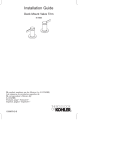
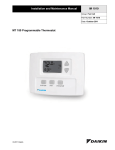
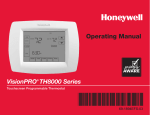

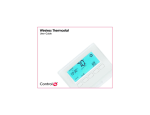

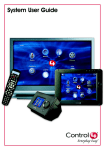

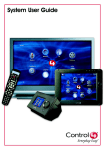
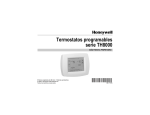
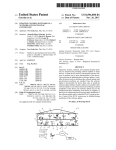
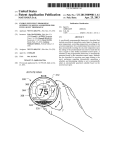
![PROTECTION] 5 E](http://vs1.manualzilla.com/store/data/005801803_1-bb6b523a92d2b05d032451f5b800ca8c-150x150.png)
